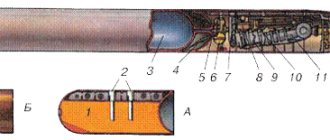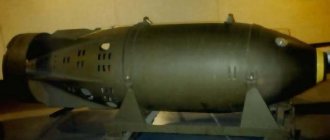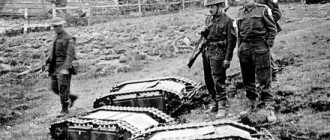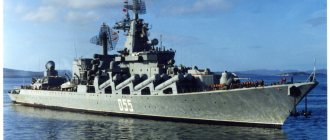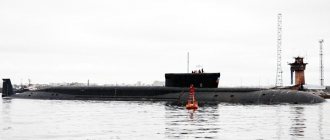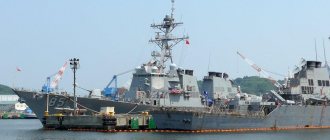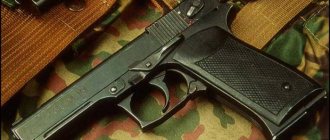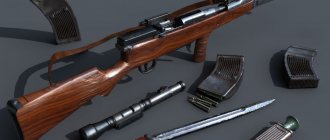Surviving copies
From top to bottom: British Mark IX, German G7e, American Mk 18
Thanks to mass production, many G7 torpedoes were preserved at submarine bases and were removed from surrendered submarines of all types at . Now G7 torpedoes of various modifications can be found in many military and specialized museums in all countries:
- Museum of the World Ocean, Kaliningrad, Russia ();
- Museum of Science and Industry, Chicago ();
- Museum of the Submarine Fleet in Balaklava ();
- Museum of the Red Banner Black Sea Fleet of the USSR, Sevastopol ();
- Wisconsin Maritime Museum ().
Other data
- The Neger man-controlled torpedo was built on the basis of the G7e torpedo.
- Based on the G7e torpedo captured by the Americans, it was constructed using reverse engineering.
- In allied documents, the Zaunkonig and Zaunkonig-II torpedoes appeared as GNAT - German Navy Acoustic Torpedo.
First torpedo launchers
In 1866, while testing the first samples of his torpedoes, Robert Whitehead
) used the most simplified launcher, which was an inclined chute into which a torpedo was installed and, after starting the engine, it was released into the water.
This design could be used during tests and experiments, but was too unreliable for use in combat conditions. Therefore, Whitehead, in parallel with work on the torpedo itself, was forced to develop torpedo launchers. In 1870, during a demonstration of his torpedoes in Great Britain, Whitehead equipped the paddle steamer Oberon
with three types of launchers: one frame and two tube launchers, for underwater and surface launches.
The frame launcher was a spatial structure from which the torpedo was suspended. To launch, the fastening locks of the torpedo were released, which was immersed in the water and the engine was started using a halyard. Tube launchers were designed based on pneumatic release systems for sea mines. They were pipes equipped with front and rear covers and a trigger hook. Before launching, the torpedo was placed in a pipe; if an underwater launch device was used, the pipe was flooded with sea water. To launch, compressed air was supplied to the breech of the pipe, which pushed the torpedo out. Before launch, it was necessary to spin up the torpedo's gyroscope, which ensured directional stability during autonomous motion. In 1881, the American inventor John Ericsson ,
who had previously designed a throwing mine, developed a gunpowder starting device. Using Ericsson's device, a motorless mine could be thrown more than 250 meters on the surface and 40 meters underwater. In addition to gunpowder and air launchers, steam and mechanical tubular devices for launching torpedoes were developed. By the beginning of the twentieth century, installations for launching torpedoes acquired a modern look and their design features and principle of operation began to be determined by the parameters of the torpedoes themselves and the characteristics of the carrier ships.
Prerequisites for creation
The German torpedo, which was developed in 1922 on the basis of torpedoes from the First World War, was already outdated both technologically and morally by 1938, but there were no new projects or ideas. That is why the Admiralty Kriegsmarine
decided to convert the G7 from a torpedo with a diameter of 500 mm to a torpedo with a diameter of 533.3 mm - 22 inches - for greater standardization and increased combat power. Subsequently, the G7 torpedo was divided into two main branches - G7a - combined-cycle and G7e - electric. The second type was developed in 1939 to counteract the main disadvantage of steam-gas torpedoes - the bubble wake, which gives away both the torpedo and the position of the submarine at the time of launch. 1940 - torpedo crisis, which is solved by new modifications of fuses.
Combat use
During World War II, the G7 torpedo and its modifications were the main torpedo adopted by the Kriegsmarine.
:
1940
_
— Submarines are equipped mainly with G7a (TI) torpedoes and a small number of G7e (TII). All torpedoes produced before 1940 are replaced and recycled as unreliable. 1942
_
— In connection with the advent of the G7e (TIII) torpedoes, submarines are beginning to be equipped with equal parts electric and steam-gas torpedoes. 1943
_
— FaT torpedoes are in service. The development of electric torpedoes allows them to almost completely replace steam-gas torpedoes. 1944
_ — The appearance of G7e torpedoes with the “Falke”, “Zaunkonig”, “Zaunkonig-II” systems and torpedoes of the LuT system changes the combat pattern of submarines, which allows them to fire torpedoes from any point - the torpedo itself will reach the enemy’s location and hit him.
The use of torpedoes on a submarine began with target detection. Next, according to the gunner’s commands, the Oberbotzmannmaat entered the target’s course, distance to it, speed and its apparent length into the Forhalterechner calculating device. The device, in addition, automatically receives data on the course of the submarine itself, its speed and the angle of aiming at the target read from the periscope. After receiving all the data, the Forhalterechner programs the torpedo in a short time and it is launched from the fire control rack. Launching torpedoes in the Kriegsmarine
, unlike other fleets, was carried out in two ways:
- underwater - the torpedo is pushed out at a speed of 10 m/s by a pneumatic piston, to which a pressure of 20-24 atmospheres is applied. The air itself, thanks to the valve system, does not escape outside and the start came out clean - without bubbles in the water. The piston returned on its own under the influence of external water pressure, after disconnecting the piston from the internal pressure source;
- surface - a normal launch, when the torpedo is pushed out by compressed air.
Countermeasures
Battleship Eustathius with anti-torpedo nets.
Designed ships began to be equipped with special passive protection systems. On the outer side of the sides, anti-torpedo boules were installed, which were narrowly directed sponsons partially filled with water. When a torpedo hit, the energy of the explosion was absorbed by the water and reflected from the side, reducing damage. After World War I, a torpedo belt was also used, which consisted of several lightly armored compartments located opposite the waterline. This belt absorbed the torpedo explosion and minimized internal damage to the ship. A type of anti-torpedo belt was the constructive underwater protection of the Pugliese system, used on the battleship Giulio Cesare.
Jet anti-torpedo protection system for ships "Udav-1" (RKPTZ-1)
To combat torpedoes that use various types of homing, ships and submarines are equipped with simulators and sources of interference that complicate the operation of various control systems. In addition, various measures are taken to reduce the physical fields of the ship. Modern ships are equipped with active anti-torpedo protection systems. Such systems include, for example, the Udav-1 (RKPTZ-1) anti-torpedo defense system for ships, which uses three types of ammunition (diverter projectile, minelayer projectile, depth projectile), a ten-barreled automated launcher with tracking tracking drives, fire control devices, loading and feeding devices.
